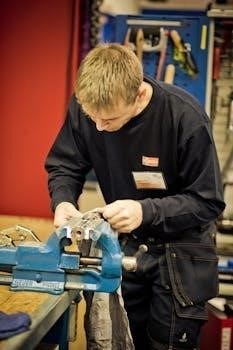Bridgeport Milling Machine Manual⁚ An Overview
This section provides a general introduction to the comprehensive manuals associated with Bridgeport milling machines, detailing their purpose in guiding users through various aspects of machine operation, maintenance, and safety․
Bridgeport milling machines are renowned for their versatility and precision in metalworking․ These machines, often referred to as “Bridgeports,” are a staple in machine shops and educational institutions globally․ Their robust design and adaptability make them suitable for a wide array of machining operations, including milling, drilling, and boring․ Manuals for these machines are crucial resources, providing users with detailed instructions on safe and efficient operation․ These manuals typically cover various models, such as the Series I and Series II, each with specific features and control configurations․ Understanding the nuances of these machines, through their respective manuals, is essential for achieving accurate and consistent machining results․ Furthermore, these manuals often include information on machine installation, maintenance schedules, and troubleshooting guidance․ The information contained within these manuals is subject to change and should always be consulted before attempting any machine operation or maintenance․ These machines utilize the rotational motion of a stationary cutter to remove material from a workpiece and it’s important to be familiar with how it works before using it․
Manuals for Bridgeport Series I Milling Machines
Manuals for the Bridgeport Series I milling machines are indispensable for operators and maintenance personnel․ These documents provide comprehensive guidance on the installation, operation, and maintenance of these widely used machines․ Typically, a Series I manual includes detailed diagrams and instructions covering various aspects of the machine, such as its controls, lubrication points, and safety features․ Specific manuals may be tailored to different sub-models within the Series I range, often identified by serial numbers or manufacturing dates․ These manuals frequently include part lists to aid in ordering replacements․ It is crucial to note that the information in these manuals is subject to change, and users should always refer to the most recent version․ Some manuals cover models with serial numbers ending with the letter ‘M’ while others cover models beginning with the letter ‘J’․ These manuals emphasize safety precautions and warnings that should be carefully reviewed before operating the machine․ These manuals also provide detailed instructions on how to operate the machine safely and efficiently․
Key Components Covered in Manuals
Bridgeport milling machine manuals typically provide detailed information on key components essential for the machine’s operation and maintenance․ These manuals thoroughly cover the machine’s head, including both J-head and 2J2-head variations, detailing their controls and operation․ The manuals also extensively address the quill and spindle, explaining their functions and maintenance procedures․ Furthermore, the transmission system is a crucial component, and the manuals provide detailed diagrams and instructions for its upkeep․ Lubrication points are clearly marked in the manuals, emphasizing their importance for the longevity of the machine’s components․ The manuals often include sections describing the various machine controls, such as the high-low range switch, variable speed dial, spindle brake, and quill feed selector․ Tables, both mechanical and those with variable feed, are described in detail as well․ These manuals often explain the correct procedures for setting up and using the vise and other workholding devices․ Proper understanding of these key components ensures safe and efficient operation․

Installation and Setup
This section details the necessary steps for the proper installation and setup of a Bridgeport milling machine, ensuring its safe and accurate operation, from preparing location to initial procedures․
Preparing the Machine Location
Before installing a Bridgeport milling machine, careful preparation of the designated location is crucial․ This involves ensuring the floor is level and capable of supporting the machine’s weight, preventing any instability during operation․ Adequate space around the machine is necessary for safe maneuvering and maintenance access․ Proper lighting is essential for clear visibility of the workpiece and machine controls․ Furthermore, the location should be free from excessive moisture and dust, which can compromise machine performance and longevity․ It’s also important to consider the proximity of power sources and ensure they meet the machine’s electrical requirements․ Sufficient ventilation is needed to dissipate any heat generated by the machine․ Lastly, confirm there’s enough clearance for any required movements of the machine․ These steps are paramount to a smooth and secure installation process․
Initial Machine Installation Procedures
The initial installation of a Bridgeport milling machine involves several critical steps․ First, carefully unpack the machine and verify all components are present, consulting the parts list in the manual․ Next, lift and position the machine onto the prepared location, ensuring it’s stable and level using appropriate leveling tools․ Connect the machine to the designated power source, adhering to all safety guidelines and electrical requirements․ Lubricate all essential parts, following the lubrication diagram provided in the manual before the first use․ Perform a visual inspection of all machine components, ensuring no parts are damaged or missing․ Test all controls and mechanisms to confirm proper functionality․ Secure all necessary guards and safety features before operation․ Prior to performing any machining operations, confirm the machine is correctly calibrated․ These procedures are crucial to ensuring safe operation and the longevity of the machine․

Operation and Controls
This section details the operational aspects of Bridgeport milling machines, covering the various controls, including those for the J-Head and 2J2-Head, and explaining how to use them effectively and safely․
Understanding Machine Controls
The Bridgeport milling machine’s operation relies on a series of carefully designed controls, each serving a specific function․ These controls are essential for precise machining operations and include elements for spindle speed adjustment, quill feed engagement, and table movement․ Understanding these controls is paramount for safe and effective machine operation․ The manuals provide detailed diagrams and explanations for each control, ensuring operators can navigate the machine’s functions with confidence․ These include the high-low range switch, variable speed dial, spindle brake, and quill feed selector․ Proper use of these controls allows for accurate material removal and precise shaping of workpieces․ Furthermore, the manuals emphasize the importance of understanding the interaction between different controls to achieve desired results․ Familiarization with these controls through the manual is crucial for any operator․ Additionally, the manuals often feature troubleshooting tips related to control operation, assisting in the resolution of common issues․ This knowledge is fundamental for maximizing the machine’s capabilities and ensuring a long service life․

Operating the J-Head Controls
Operating a Bridgeport milling machine with a J-head requires a thorough understanding of its specific controls․ The J-head, a common configuration, features controls for spindle speed adjustment, quill feed, and directional movement․ The manual provides detailed instructions on how to engage and disengage the quill feed mechanism, essential for drilling and precise depth control; The variable speed dial allows for fine-tuning spindle speed, crucial for different materials and cutting tools․ Operators must familiarize themselves with the location and function of each control․ The manual includes diagrams and step-by-step instructions for performing various machining operations using the J-head․ Proper use of these controls is vital for safety and quality․ Additionally, understanding the interaction between these controls is paramount for achieving accurate results․ The manual often includes troubleshooting tips specific to the J-head, assisting in resolving common operational issues․ Operators should consult the manual regularly to maintain proficiency and ensure optimal machine performance․ Furthermore, safe operating procedures must be followed to prevent injury․
Operating the 2J2-Head Controls
The 2J2-head on a Bridgeport milling machine introduces a different set of controls that require specific understanding for safe and effective operation․ This head typically incorporates additional features compared to the J-head, demanding a careful approach to machine handling․ The manual meticulously details each control’s function, from the high-low range switch for spindle speed adjustments to the quill feed selection mechanism․ Operators must be proficient in using the variable speed dial to precisely control spindle rotation․ The 2J2-head often includes a spindle brake that must be used correctly to avoid damage; Detailed instructions on using the quill feed mechanism are provided for drilling and controlled depth applications․ Understanding the interactions between these various controls is key to efficient machining․ The manual includes diagrams and troubleshooting guides specific to the 2J2-head․ Proper operation of these controls ensures accuracy and extends the life of the machine․ Safety procedures outlined in the manual must be strictly followed․ Operators should refer to this section regularly to maintain proficiency․

Maintenance and Safety
This section outlines critical maintenance procedures, including lubrication guidelines and inspection routines, alongside vital safety precautions and warnings to ensure the safe and efficient operation of the Bridgeport milling machine․
Lubrication Procedures
Proper lubrication is paramount for the longevity and smooth operation of your Bridgeport milling machine․ Neglecting this crucial aspect can lead to premature wear and potential damage to vital components․ The machine manual provides detailed instructions on the specific types of lubricants recommended for various parts, such as the spindle, quill, and ways․ It’s essential to adhere to the recommended lubrication schedule outlined in the manual, typically involving daily, weekly, or monthly intervals depending on usage intensity․ Before each operation, ensure all designated lubrication points have received the correct amount of lubricant․ This includes checking oil levels in reservoirs and using grease fittings where applicable․ The manual also emphasizes the importance of using clean lubricants and avoiding contamination․ Always refer to the specific manual for your model, as lubrication requirements may vary․ Regular and meticulous lubrication is a cornerstone of preventative maintenance for your Bridgeport milling machine․ Following the guidelines closely will ensure optimal performance and extend the machine’s lifespan, saving time and money in the long run․ Ignoring this critical area can lead to costly breakdowns․
Safety Precautions and Warnings
Operating a Bridgeport milling machine requires strict adherence to safety precautions to prevent accidents and injuries․ The machine manual contains vital safety warnings and guidelines that must be thoroughly understood and followed․ Always wear approved industrial safety glasses to protect your eyes from flying debris․ Never operate the machine while wearing loose clothing, jewelry, or long hair, which could get caught in moving parts․ It is strictly prohibited to operate the machine under the influence of drugs or alcohol․ Keep the work area clean and free of obstructions․ Before starting any operation, ensure all guards are in place and functioning correctly․ Never attempt to make adjustments or repairs while the machine is running․ Always disconnect the power source before performing maintenance․ Familiarize yourself with the location of the emergency stop button․ Pay attention to all warning labels and symbols on the machine․ Do not exceed the machine’s operational limits․ Always use the correct tools and accessories for the job․ Only trained personnel should operate the milling machine․ Ignoring these crucial safety measures can lead to serious injuries and even fatalities․ The manual is a critical resource for safety․
Routine Maintenance and Inspection
Regular maintenance and thorough inspections are crucial for ensuring the longevity and optimal performance of your Bridgeport milling machine․ The manual provides detailed procedures for routine checks and maintenance tasks․ Regularly inspect all moving parts for wear, damage, or looseness․ Check the spindle, quill, and bearings for any unusual noises or vibrations․ Ensure all belts are properly tensioned and in good condition․ Lubricate all necessary points according to the manual’s instructions․ Pay attention to the condition of the lead screws and their nuts․ Examine the machine’s electrical components for any signs of damage or loose connections․ Check the condition of the coolant system and ensure that it is functioning correctly․ Clean the machine regularly to remove chips and debris․ Keep the work area around the machine clean and organized․ Before each use, perform a quick check of the machine’s overall condition․ Record any maintenance or inspection activities in a logbook․ Address any issues promptly to prevent further damage․ Following the recommended maintenance schedule in the manual will help keep your Bridgeport milling machine in top working order and extend its lifespan․ These tasks are vital for safe operation․
